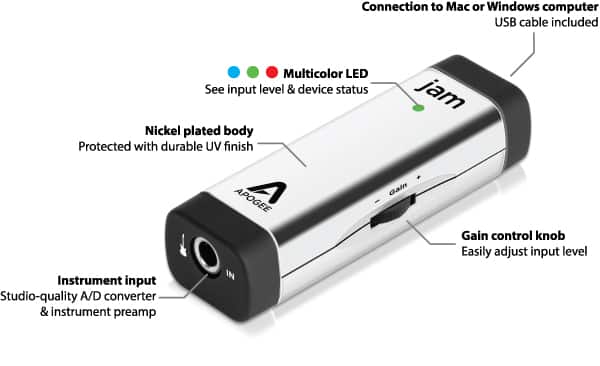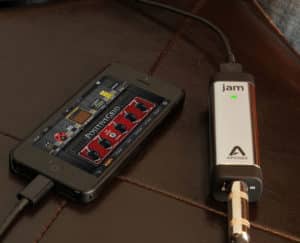
The original Jam was one of a few high profile ‘breakout’ devices back in 2012 when recording on the go using your iPhone or iPad became a reality.
Positioning itself as a direct competitor to IK Multimedia’s then ubiquitous (but ultimately limited) iRig, the original Jam wowed users with it’s fantastic sound quality and stylish design.
Fast forward to present day and there’s no shortage of compact, portable interfaces on the market. Does Apogee’s updated Jam 96k do enough to separate itself from the rest?
The Jam 96k certainly makes a good first impression.
Upon opening the box, you’ll find Apogee’s redesigned unit nestled snugly in some good quality foam packaging , along with either a solitary Jam to USB cable, or USB and lightning cable, depending on which version you’ve purchased (more on this later).

Build quality here is great – the faux metal casing coupled with the rubber at either end of the unit give it a feeling of indestructibility.
Setting up to record with the Jam96k in GarageBand is super simple. Attaching the unit with a USB connection is enough to have GarageBand prompt an input change.
Apogee have kept things simple control wise here too, with one gain control knob along with a single LED on the front of the unit which changes colour depending on how hot you dial in the gain.
There’s only one jack input and one output connection for either the provided USB cable, or – if you’ve forked out an extra $30 for the Mac & iOS version – Lightning cable.
 You see there are a few versions of the Jam96k available; a Mac & Windows version ($99), which comes bundled with only the Jam 96k and USB cable or the Mac and iOS version ($129), which has both USB and Lightning cables.
You see there are a few versions of the Jam96k available; a Mac & Windows version ($99), which comes bundled with only the Jam 96k and USB cable or the Mac and iOS version ($129), which has both USB and Lightning cables.
It seems like a strange decision to make customers pay an extra $30 for a Lightning connector, especially as many of the Jam 96k’s competitors come with a variety of cables as standard – at much lower prices.
So what exactly are you spending all that extra cash on?
Things make a bit more sense once you plug in and start recording.
Apogee have upgraded the Jam 96k’s circuit design over the original version. Couple that with the complete lack of latency and higher sample rate recording available and it’s surprising just how good your recordings can sound.
I experienced a crystal clear signal through the entirety of my time using the Jam 96k. Clean tones sounded crisp, while more driven tones came through loud and clear, without any muddiness.
The sound clip below was recorded by Silvertide guitarist Nick Perri, using the Apogee Jam96k into an iPhone running GarageBand iOS:
There’s no denying the Jam 96k sounds fantastic, but how does it measure up against it’s competitors?
IK Multimedia recently released a firmware update for it’s iRig HD guitar interface, allowing it to record 24bit/96kHz audio. Considering that the iRig HD is considerably cheaper than the Jam 96k, you would expect a very noticeable difference in audio quality…
Right?
I put together a Sound Quality Face Off comparison video to find out how the two interfaces compare.
The Verdict
